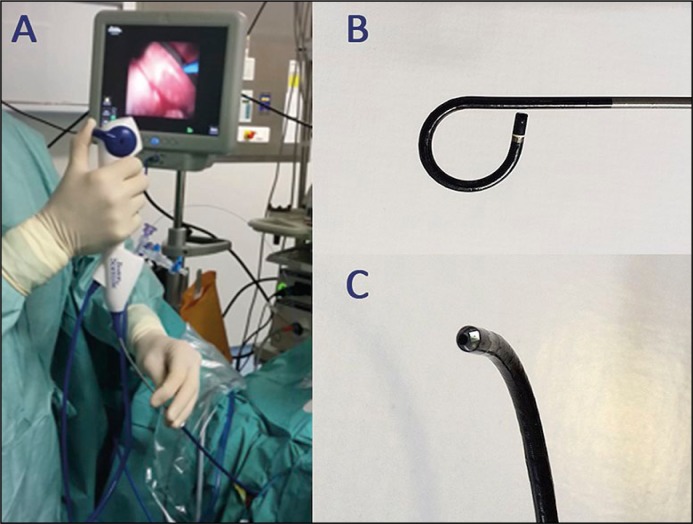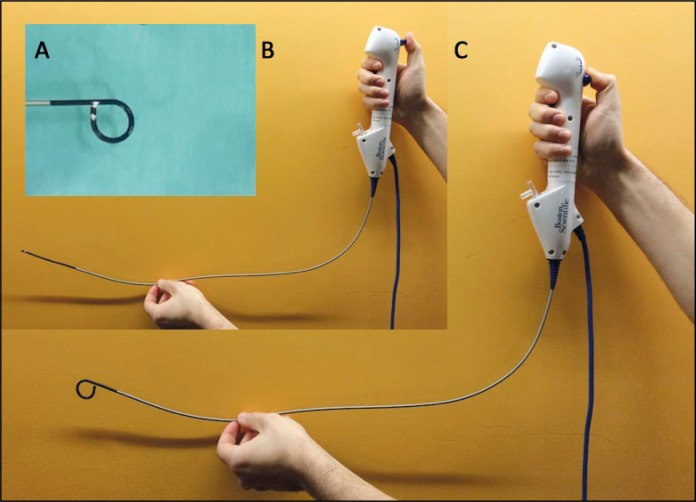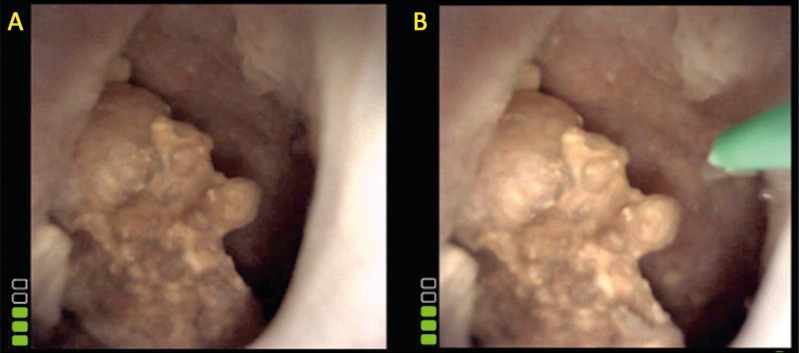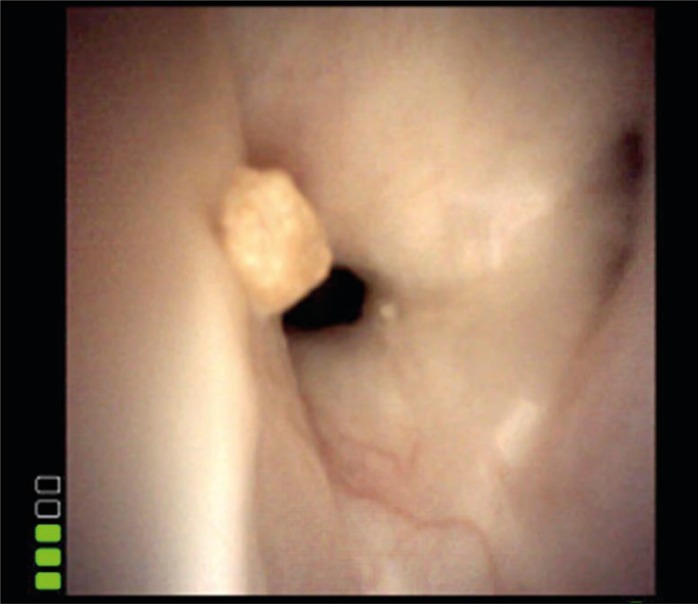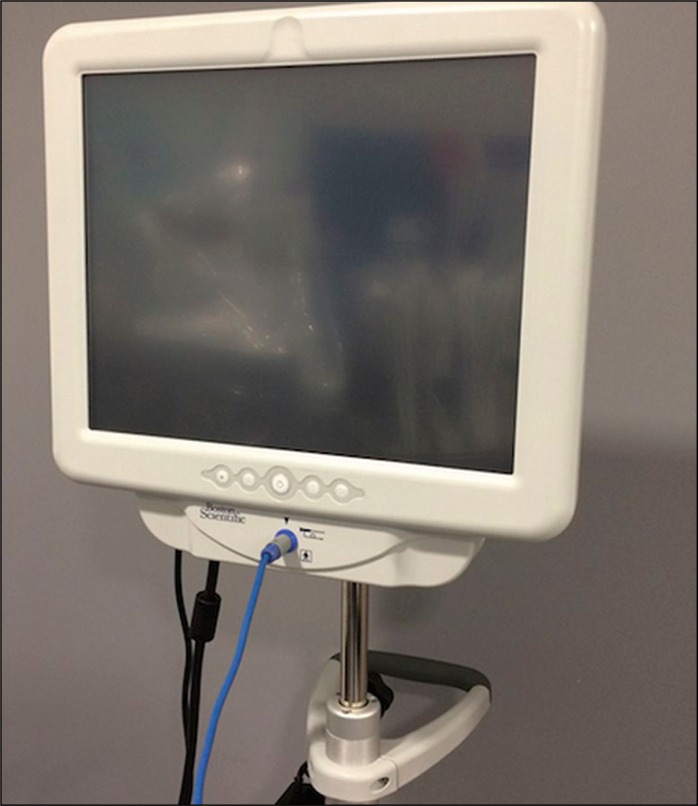INTRODUCTION
Over the last 20 years new technologies have emerged in urology, while there has been an increase in the incidence of kidney stone disease with growing use of flexible ureteroscopy [1]. In 2004 Gyrus ACMI introduced the first totally digital flexible ureteroscopic system, the DUR-D Invisio platform [2]. This was a watershed moment as all the major companies began producing digital flexible ureteroscopes from that moment forward with an improved armamentarium available for the urologist [3]. In October 2015 Boston Scientific introduced the LithoVue™. This is the first single-use flexible ureteroscope developed to access the upper urinary tract.
The LithoVue™
The LithoVue™ (Boston Scientific, Marlborough, MA) is a new single-use digital flexible ureteroscope (Figure 1).
Figure 1.
The new single use flexible ureteroscope: LithoVue™. A. The LithoVue™ external aspect in the hands of the surgeon and the LithoVue™ monitor can be seen at the back. B. Maximum deflection of the ureteroscope tip; 270° in both directions. C. Close view of the tip, it’s possible to appreciate the small diameter of 7.7 Fr.
The handle is extremely ergonomic, permitting the user to easily perfom the 6 principal movements in a natural way (deflection: up/down, supination/pronation, forward/backward). The deflection system has both options of standart and the reverse modes with a maximum deflection of 270˚ in both directions (Figures 1 & 2). The outer diameter is 9.5 Fr (≤3.23 mm) and the tip diameter is 7.7 Fr (Figures 1 & 2). These diameters allow endourologists to work with all of the ureteral access sheaths currently on the market.
Figure 2.
External view of the LithoVue™. A. The tip at maximum deflection. B. External view of the device with the tip straight. C. External view of the device with the tip at maximum deflection.
The working channel width measures 3.6 Fr and allows the introduction of various endoscopic instruments such as laser fibers, baskets and different kinds of graspers (Figure 3).
Figure 3.
Endoscopic view from the LithoVue™ demonstrating the digital image quality during upper urinary tract endoscopy. A. Kidney stone inside the caliceal system. B. Kidney stone and a green coated 272 μm laser fiber.
In order to maximize the vision it has a complementary metal-oxide-semiconductor (CMOS) imager system with a working distance of 2–50 mm (Figures 3 & 4).
Figure 4.
Endoscopic view from the LithoVue™ demonstrating the digital image quality during upper urinary tract endoscopy. A stenotic infundibulum and a small stone fragment can be seen.
The LithoVue™ possesses chip-on-the-tip technology as the camera and light source are fully integrated in the scope, and it has a workstation monitor with the integrated image processing software mounted on a compact, rolling mobile cart. It is possible to use the LithoVue™ system alone or to connect it to the operating room’s existing DVI monitors and recording systems (Figure 5).
Figure 5.
Monitor station of the LithoVue™ at Tenon University Hospital.
DISCUSSION
Different flexible ureteroscopes are on the market, including fiberoptic and digital versions. The latter offer better vision quality, though in their study comparing digital versus fiber-optic scopes, Somani et al. found the only advantage of the digital scope in cases of stone treatment was the decrease in operative time by 20% [4]. It is important to note that the European Association of Urology (EAU) guidelines state the importance of using the technological advancements in the treatment of upper urinary tract tumors [5].
However, the increasing improvement of ureteroscopes has led to several problems. The principal issue is durability and depends on many factors such as a surgeon’s experience and skills, time of use, and the use of other devices or instruments. Another important, open question is the sterilisation factor when considering scope damage. Abraham et al. demonstrated that two identical fiberoptic scopes underwent two different sterilisation processes (Steris 1™ and Cidex OPA) after 100 cycles. The first one, which was sterilised in the Steris system, had a 12-mm tear on its shaft, 297 damaged fibers, and a 37% drop in resolution. The second, sterilised with Cidex, had only 10 damaged fibers and no visible external damage [6].
The durability of flexible ureteroscopes has been a concern for many years. Refurbished flexible ureteroscopes have been reported to be very fragile after undergoing comprehensive repair, especially if they are used by multiple surgeons and this situation leads to significant maintenance, repair, and administrative costs [7]. Actually, there are studies showing some advancements of ureteroscope durability with repeated uses of up to 107.7 hours with a single ureteroscope, but still the latest data is telling us that the durability of flexible ureteroscopes needs to be improved [8]. Additionally it should be kept in mind that, with LithoVue™, the performance of a brand-new endoscope is experienced in each procedure, bypassing the loss of deflection with repeated use.
When cost-effectiveness is evaluated, the reusable flexible ureteroscopes are burdened with purchase, repair, and service costs in addition to cleaning, disinfection and sterilization costs as well as costs related to health care and time consumption. However, single-use flexible ureteroscopes bring with them purchase and storage costs of the scopes themselves and their corresponding work stations as well as costs related to waste handling. Ureteroscopes represent semicritical devices due to their contact with patients’ mucous membranes and must be sterilized with high-level disinfectants. Failure to properly disinfect the scopes can lead to transmission of infection [9]. The working channel of the ureteroscopes must be actively perfused with high-level disinfectants otherwise disinfection does not occur [9]. These steps are also acknowledged by the American Urological Association and failure to comply can result in urinary tract infections [10]. This process constitutes one of the major steps that accounts for the high expenditure of re-usable scopes. It should also be emphasized that the price of the LithoVue™ should be discussed with the local company in each country because the costs may change according to different purchasing options as well as different countries.
All of these problems can be avoided by using the LithoVue™, which guarantees performance equal to that of new reusable ureteroscopes but without the risk of possible contamination.
The optical characteristics of the LithoVue™, the Flex-Xc (Karl Storz, Germany) and the Cobra (Richard Wolf, Germany) were compared by Kaplan et al. who concluded that the LithoVue™ has superb optical capabilities, deflection and flow, thus making it a viable alternative to standard non-disposable 4th generation flexible digital and fiberoptic ureteroscopes [11]. Furthermore, in their study on fresh cadavers, Proietti et al. compared the LithoVue™ with other ureteroscopes and demonstrated that the vision and handling are comparable to other ureteroscopes. LithoVue™ was preferred in all of the renal units used in these experiments due to its maneuverability [12].
CONCLUSIONS
LithoVue™ is a new flexible ureteroscopy concept and is comparable with other ureteroscopes that already exist on the market in all basic characteristics. By employing a single-use ureteroscope all the problems caused by reusable ureteroscopes are also overcome.
CONFLICTS OF INTEREST
The authors declare no conflicts of interest.
References
- 1.Ghani KR, Sammon JD, Karakiewicz PI, et al. Trends in surgery for upper urinary tract calculi in the USA using the Nationwide Inpatient Sample: 1999-2009. BJU Int. 2013;112:224–230. doi: 10.1111/bju.12059. [DOI] [PubMed] [Google Scholar]
- 2.Shah K, Monga M, Knudsen B. Prospective Randomized Trial Comparing 2 Flexible Digital Ureteroscopes: ACMI/Olympus Invisio DUR-D and Olympus URF-V. Urology. 2015;85:1267–1271. doi: 10.1016/j.urology.2014.12.012. [DOI] [PubMed] [Google Scholar]
- 3.Buttice S, Sener TE, Proietti S, et al. Temperature Changes Inside the Kidney: What Happens During Holmium:Yttrium-Aluminium-Garnet Laser Usage? J Endourol. 2016;30:574–579. doi: 10.1089/end.2015.0747. [DOI] [PubMed] [Google Scholar]
- 4.Somani BK, Al-Qahtani SM, de Medina SD, Traxer O. Outcomes of flexible ureterorenoscopy and laser fragmentation for renal stones: comparison between digital and conventional ureteroscope. Urology. 2013;82:1017–1019. doi: 10.1016/j.urology.2013.07.017. [DOI] [PubMed] [Google Scholar]
- 5.Rouprêt M, Babjuk M, Compérat E, et al. European guidelines on upper tract urothelial carcinomas: 2013 update. Eur Urol. 2013;63:1059–1071. doi: 10.1016/j.eururo.2013.03.032. [DOI] [PubMed] [Google Scholar]
- 6.Abraham JBA, Abdelshehid CS, Lee HJ, et al. Rapid Communication: Effects of Steris 1™ Sterilization and Cidex® Ortho-Phthalaldehyde High-Level Disinfection on Durability of New-Generation Flexible Ureteroscopes. J Endourol. 2007;21:985–992. doi: 10.1089/end.2007.0181. [DOI] [PubMed] [Google Scholar]
- 7.Carey RI, Martin CJ, Knego JR. Prospective evaluation of refurbished flexible ureteroscope durability seen in a large public tertiary care center with multiple surgeons. Urology. 2014;84:42–45. doi: 10.1016/j.urology.2014.01.022. [DOI] [PubMed] [Google Scholar]
- 8.Shin RH, Lipkin ME, Preminger GM. Disposable devices for RIRS: Where do we stand in 2013? What do we need in the future? World J Urol. 2015;33:241–246. doi: 10.1007/s00345-014-1368-4. [DOI] [PubMed] [Google Scholar]
- 9.Rutala WA, Weber DJ. Reprocessing semicritical items: Current issues and new technologies. Am J Infect Control. 2016;44:e53–62. doi: 10.1016/j.ajic.2015.12.029. [DOI] [PubMed] [Google Scholar]
- 10.Clemens JQ, Dowling R, Foley F, et al. Joint AUA/SUNA white paper on reprocessing of flexible cystoscopes. J Urol. 2010;184:2241–2245. doi: 10.1016/j.juro.2010.08.001. [DOI] [PubMed] [Google Scholar]
- 11.Kaplan A, Neisius A, Radvak D, et al. 1031 Evaluation of a novel single use flexible ureteroscope. Eur Urol Suppl. 2016;3:e1031. [Google Scholar]
- 12.Proietti S, Dragos L, Molina W, Doizi S, Giusti G, Traxer O. Comparison of New Single-Use Digital Flexible Ureteroscope Versus Nondisposable Fiber Optic and Digital Ureteroscope in a Cadaveric Model. J Endourol. 2016;30:655–659. doi: 10.1089/end.2016.0051. [DOI] [PMC free article] [PubMed] [Google Scholar]



